9 items found
Page 1 of 1
-
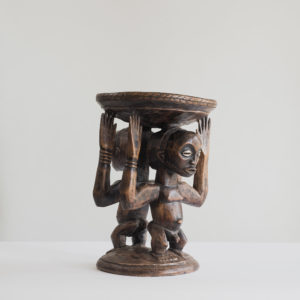
Luba female / male stool,
£375Luba female / male stool,
Luba art relates most commonly to the Kings and Chiefs of the Congolese Luba tribe, who would assert their power by display of ceremonial objects during ceremonies. Stools were considered to be the most important of these objects as they would serve not only as a seat but as a receptacle for the Chief’s spirit. The ruler is thus figuratively and literally supported by a caryatid figure - in this case both male and female standing figures. The male is seen with inset cowrie shell eyes, believed by many African tribes to contain divine powers.£375 -
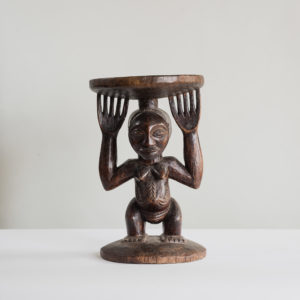
Luba stool
£375Luba stool
Luba art relates most commonly to the Kings and Chiefs of the Congolese Luba tribe, who would assert their power by display of ceremonial objects during ceremonies. Stools were considered to be the most important of these objects as they would serve not only as a seat but as a receptacle for the Chief’s spirit. The ruler is thus figuratively and literally supported by a caryatid figure - in this case a standing female ancestor. The carvings seen on her stomach allude to the maternal - such markings were common among many matrilineal societies in Africa to emphasise and protect the navel as the threshold between oneself, one’s mother and one’s own lineage.£375 -
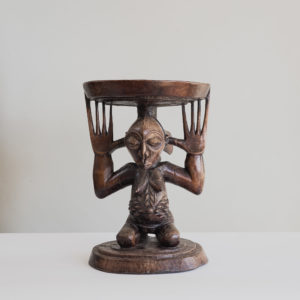
Luba stool,
£350Luba stool,
Luba art relates most commonly to the Kings and Chiefs of the Congolese Luba tribe, who would assert their power by display of ceremonial objects during ceremonies. Stools were considered to be the most important of these objects as they would serve not only as a seat but as a receptacle for the Chief’s spirit. The ruler is thus figuratively and literally supported by a caryatid figure - in this case a kneeling female ancestor with elongated and outstretched fingertips. The deep carvings seen on her stomach allude to the maternal - such markings were common among many matrilineal societies in Africa to emphasise and protect the navel as the threshold between oneself, one’s mother and one’s own lineage.£350 -
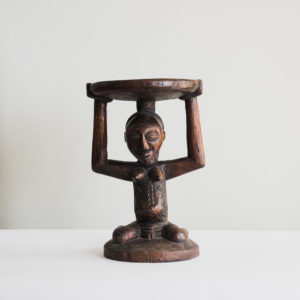
Tabwa stool
£350Tabwa stool
Congolese Tabwa art has distinct similarities to that of the Luba tribe, and its stools are used also in ceremonies by the Kings and Chiefs of the community with a means of establishing power and authority. The key difference seen between the two is the Tabwa’s traditional depiction of braided hair as a carved extension of the head and checkerboard-style scarification of the woman’s body.£350 -
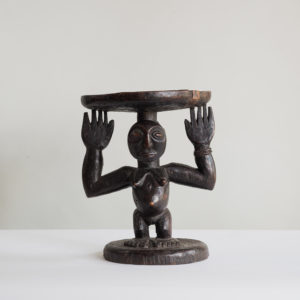
Luba stool
£325Luba stool
Luba art relates most commonly to the Kings and Chiefs of the Congolese Luba tribe, who would assert their power by display of ceremonial objects during ceremonies. Stools were considered to be the most important of these objects as they would serve not only as a seat but as a receptacle for the Chief’s spirit. The ruler is thus figuratively and literally supported by a caryatid figure - in this case a posed female ancestor with a carved headdress and jewellery.£325 -
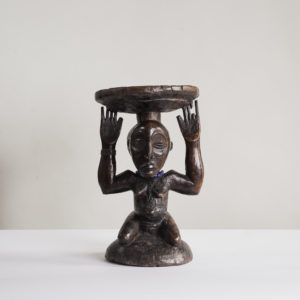
Luba stool
£325Luba stool
Luba art relates most commonly to the Kings and Chiefs of the Congolese Luba tribe, who would assert their power by display of ceremonial objects during ceremonies. Stools were considered to be the most important of these objects as they would serve not only as a seat but as a receptacle for the Chief’s spirit. The ruler is thus figuratively and literally supported by a caryatid figure - in this case a kneeling female ancestor adorned with beaded and carved jewellery. The deep carvings seen on her stomach allude to the maternal - such markings were common among many matrilineal societies in Africa to emphasise and protect the navel as the threshold between oneself, one’s mother and one’s own lineage. Damage to left hand.£325 -
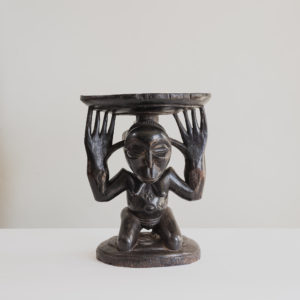
Luba stool,
£300Luba stool,
Luba art relates most commonly to the Kings and Chiefs of the Congolese Luba tribe, who would assert their power by display of ceremonial objects during ceremonies. Stools were considered to be the most important of these objects as they would serve not only as a seat but as a receptacle for the Chief’s spirit. The ruler is thus figuratively and literally supported by a caryatid figure - in this case a kneeling female ancestor with elongated and outstretched fingertips. The deep and patterned carvings seen on her stomach allude to the maternal - such markings were common among many matrilineal societies in Africa to emphasise and protect the navel as the threshold between oneself, one’s mother and one’s own lineage.£300 -
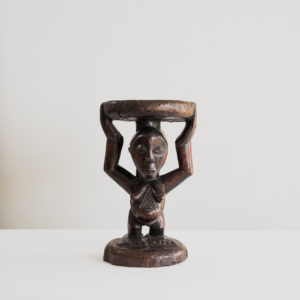
Luba stool
£275Luba stool
Luba art relates most commonly to the Kings and Chiefs of the Congolese Luba tribe, who would assert their power by display of ceremonial objects during ceremonies. Stools were considered to be the most important of these objects as they would serve not only as a seat but as a receptacle for the Chief’s spirit. The ruler is thus figuratively and literally supported by a caryatid figure - in this case a posed female ancestor with a carved headdress. The deep and patterned carvings seen on her stomach allude to the maternal - such markings were common among many matrilineal societies in Africa to emphasise and protect the navel as the threshold between oneself, one’s mother and one’s own lineage. The act of scarification will have often been used as a rite of passage, in order to symbolise a readiness for the pain of childbirth.£275 -
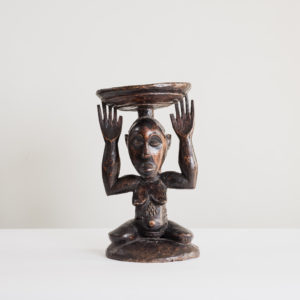
Tabwa stool
£275Tabwa stool
Congolese Tabwa art has distinct similarities to that of the Luba tribe, and its stools are used also in ceremonies by the Kings and Chiefs of the community with a means of establishing power and authority. The key difference seen between the two is the Tabwa’s traditional depiction of braided hair as a carved extension of the head and checkerboard-style scarification of the woman’s body. Such markings were common among many matrilineal societies in Africa to emphasise and protect the navel as the threshold between oneself, one’s mother and one’s own lineage.£275
Featured Items
-
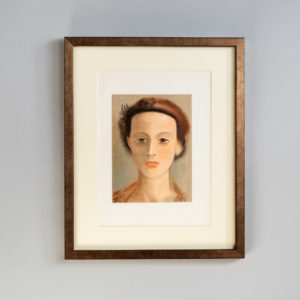
Portrait by Andre Derain, Verve Vol 2 / No. 5-6.
£800Portrait by Andre Derain, Verve Vol 2 / No. 5-6.
The Verve Review was a purposefully luxurious. It ran from 1937 to 1960, but with only 38 editions available, due to the high degree of design and editorial work dedicated to each issue. Each edition contained unique lithographic prints, commissioned by the editor, and each cover a double-page lithograph elaborated by one of the artists contained within. It was the brainchild of its editor Stratis Eleftheriades, a Greek National who moved to Paris in the early thirties to take part in the growing Modernist movement, writing under the name of Teriade.£800 -
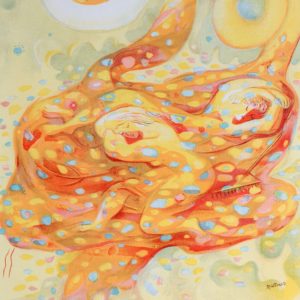
Autumn by Abraham Rattner, Verve Vol. 1 / No. 3.
£600Autumn by Abraham Rattner, Verve Vol. 1 / No. 3.
The Verve Review was a purposefully luxurious. It ran from 1937 to 1960, but with only 38 editions available, due to the high degree of design and editorial work dedicated to each issue. Each edition contained unique lithographic prints, commissioned by the editor, and each cover a double-page lithograph elaborated by one of the artists contained within. It was the brainchild of its editor Stratis Eleftheriades, a Greek National who moved to Paris in the early thirties to take part in the growing Modernist movement, writing under the name of Teriade.£600 -
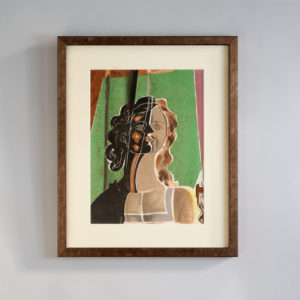
Figure by Georges Braque, Verve Vol 2 / No. 5-6.
£800Figure by Georges Braque, Verve Vol 2 / No. 5-6.
The Verve Review was a purposefully luxurious. It ran from 1937 to 1960, but with only 38 editions available, due to the high degree of design and editorial work dedicated to each issue. Each edition contained unique lithographic prints, commissioned by the editor, and each cover a double-page lithograph elaborated by one of the artists contained within. It was the brainchild of its editor Stratis Eleftheriades, a Greek National who moved to Paris in the early thirties to take part in the growing Modernist movement, writing under the name of Teriade.£800 -
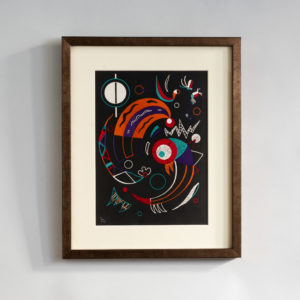
Comets by Wassily Kandinsky, Verve Vol. 1 / No. 2.
£800Comets by Wassily Kandinsky, Verve Vol. 1 / No. 2.
The Verve Review was a purposefully luxurious. It ran from 1937 to 1960, but with only 38 editions available, due to the high degree of design and editorial work dedicated to each issue. Each edition contained unique lithographic prints, commissioned by the editor, and each cover a double-page lithograph elaborated by one of the artists contained within. It was the brainchild of its editor Stratis Eleftheriades, a Greek National who moved to Paris in the early thirties to take part in the growing Modernist movement, writing under the name of Teriade.£800
